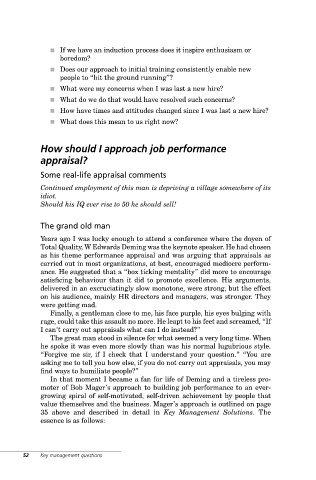Page 83 - SKU-000506274_TEXT.indd
P. 83
n If we have an induction process does it inspire enthusiasm or
boredom?
n Does our approach to initial training consistently enable new
people to “hit the ground running”?
n What were my concerns when I was last a new hire?
n What do we do that would have resolved such concerns?
n How have times and attitudes changed since I was last a new hire?
n What does this mean to us right now?
How should I approach job performance
appraisal?
Some real-life appraisal comments
Continued employment of this man is depriving a village somewhere of its
idiot.
Should his IQ ever rise to 50 he should sell!
The grand old man
Years ago I was lucky enough to attend a conference where the doyen of
Total Quality, W Edwards Deming was the keynote speaker. He had chosen
as his theme performance appraisal and was arguing that appraisals as
carried out in most organizations, at best, encouraged mediocre perform-
ance. He suggested that a “box ticking mentality” did more to encourage
satisficing behaviour than it did to promote excellence. His arguments,
delivered in an excruciatingly slow monotone, were strong, but the effect
on his audience, mainly HR directors and managers, was stronger. They
were getting mad.
Finally, a gentleman close to me, his face purple, his eyes bulging with
rage, could take this assault no more. He leapt to his feet and screamed, “If
I can’t carry out appraisals what can I do instead?”
The great man stood in silence for what seemed a very long time. When
he spoke it was even more slowly than was his normal lugubrious style.
“Forgive me sir, if I check that I understand your question.” “You are
asking me to tell you how else, if you do not carry out appraisals, you may
find ways to humiliate people?”
In that moment I became a fan for life of Deming and a tireless pro-
moter of Bob Mager’s approach to building job performance to an ever-
growing spiral of self-motivated, self-driven achievement by people that
value themselves and the business. Mager’s approach is outlined on page
35 above and described in detail in Key Management Solutions. The
essence is as follows:
52 Key management questions

